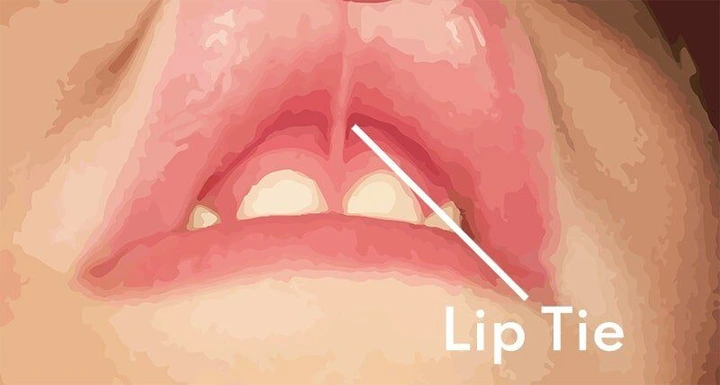Lip Tie in Babies & Toddlers: Identifying, Symptoms & Treatment


A lot of people have heard of babies having tongue ties. But a baby lip tie is an entirely different issue! Lip ties may not be as obvious from a young age, but their presence can play a big impact on your child’s future diet, oral hygiene, and speech development.
Knowing how to spot a baby lip tie can help your family avoid preventable issues before they have a chance to start. Your family dentist, pediatrician, lactation consultant, pediatric dentist, and/or myofunctional therapist can help if you’re not sure what to look for.
What Is A Baby Lip Tie?
A baby lip tie is a condition that’s caused by too-tight of a “labial frenum” or “labial frenulum”. Labial means lips, so in this case the skin involved in the lip tie is connected at the lip. A frenum or frenulum — which are both terms that get interchanged depending on who you’re asking — is the strip of skin that connects adjacent structures. For instance, your baby may have a tongue tie if their lingual (tongue) frenum is too tight at the floor of their mouth. But in this case, a tight labial (lip) frenum or frenulum means their lip is connected too tightly. AKA a “lip tie”.
Everyone has a labial frenulum on their top and bottom lip. But if it’s too tight or restricted, it prevents the lip from being able to move around as freely as someone with a looser frenum. As you might guess, the tighter the tissue, the more challenging it is for your child to speak or eat.
What Does A Lip-Tie Look Like?
Using your hands (freshly washed, of course!), gently pull the lip back. Look between the lip and the gums and you’ll see a vertical strip of skin that attaches somewhere at the base of the gums and at the inside of the lip, directly in the middle.

Lip ties can have frenums that attach “higher” on the gums or lip. They can also be thicker in some children, restricting lip movement simply because of the density of the tissue.
Baby Lip Tie Symptoms
If you’re dealing with a baby lip tie, your infant could become fussy or frustrated during feedings. You may notice that they don’t seem to eat enough or as long as they ought to. Sometimes, they tend to be irritable or may wear themselves out.
The older your baby gets and the longer the lip tie goes untreated, the more likely you’ll see an impact on their speech development — particularly when it comes to the inability to form certain sounds.
Lip ties also make it difficult for your child to eat solid foods or for you to brush their front teeth, due to how tightly the tissues are attached.
Treatment For Lip-Tie
Unfortunately, there are some healthcare providers that believe that lip ties in toddlers can tear and correct themselves. For example, your healthcare provider may have told you that a simple fall when your baby is learning to walk, or a bump to the mouth when they’re learning to use a cup could be just rough enough to detach that tense tissue. However, according to myofunctional therapy experts, this is not the case. The labial frenulum can not simply fix itself over time, and if it did end up detaching due to trauma – there’s no way to tell if it correctly detached without a medical expert.
In addition, the facial bones grow and the placement of the frenum can change. So, if your pediatric dentist or pediatrician recommends waiting until your child is a little older before trying to treat the lip tie… it can’t hurt to get a second opinion from an additional specialist.
Because if a baby’s lip tie is severe enough, then it’s time to correct it! The clinical treatment will involve a small incision or laser treatment to the frenum. This lip tie treatment can typically be performed with a small amount of numbing gel or local anesthetic. In most cases your child won’t need anything more than some Motrin or Tylenol to alleviate irritation for a day or two.
Lip Tie Complications
Lip ties in children typically cause the following significant complications:
1) Impaired Speech
Just like a tongue tie can impact the ability to form letter sounds, so can a baby lip tie. Your little one’s early babble may sound the same as other babies, but as your toddler grows into a preschooler, their untreated lip tie can cause significant speech challenges.
2) Difficulty Nursing Or Eating
3) Increased Risk Of Dental Problems
Due to the close proximity of the lip to the front teeth, it’s more challenging to fit a toothbrush into these spaces. As a result, plaque buildup tends to stay on your child’s teeth longer. In turn, those parts of their mouth see an uptick in tooth decay and gum infections.
4) Growth Patterns
The way your baby latches during feedings as an infant directly impacts the directional growth of their facial bones. A baby with a lip tie or tongue tie may have a different skeletal structure as they grow than their siblings do.
Preventing Tooth Decay
When you’re brushing your baby or toddler’s teeth, any area with a lip tie is going to be more challenging to access. In fact, their lip might cover half of their teeth or more when you’re trying to brush the front surfaces. To help, use one hand to gently pull the lip back. Then with the other hand, angle the toothbrush bristles toward their gums, brushing at a slant instead of straight-on. Repeat this twice per day. It’s important for parents to be proactive in helping their child avoid the added risk of tooth decay.
Even as your child grows older and begins to brush on their own, always go back and check (or re-brush) areas where a lip tie is involved. Otherwise, your child might inadvertently skip over those spaces.
Lip Tie Vs. Labial Frenulum
Every typically developed baby (assuming there are no clefts or other developmental concerns) will have a “labial frenulum” or “labial frenum” between their lip and gum tissues. It’s a normal part of oral anatomy! Just like the “lingual” version that’s under their tongue, there will naturally be at least some strip of tissue in that place.
The issue that brings lip ties into play is when that labial frenulum is too tight or thick. At that point, the frenum can’t stretch or allow as much mobility because it’s so tight. It’s this specific scenario where a labial frenulum creates the condition called a “lip tie.” The frenulum is the anatomy, but the lip tie is the complication caused by too tight of skin. Lip tie or not, there will always be a frenum.
Breastfeeding Difficulties with Lip-Ties
Whether bottle feeding or breastfeeding, your baby needs to get a good “latch” in order to suckle correctly. Otherwise, they won’t be able to draw in as much breast milk or it can actually feel painful to the nursing mother. Even with changing up nursing positions, using nipple shields, or trying out various bottle designs, a baby with a lip tie may still struggle to feed well.
If you struggle with nursing, one of the best first steps to take is to visit with a lactation consultant. These breastfeeding experts can also take a peek at your child’s mouth to determine if something like a baby lip tie or tongue tie could be interfering with their ability to latch.
How To Feed A Child With A Lip Tie
Babies with a severe lip tie will need corrective treatment in order to nurse or feed effectively. Again, visiting with your pediatrician, a lactation consultant, a myofunctional therapist, or a pediatric dentist can help you determine if treatment is required and address the issue quickly.
Even with treatment, adjusting to proper and comfortable feeding can take some patience. Especially if your child has to re-learn how to latch onto a bottle or breast. Here’s where — once again — partnering with that lactation consultant can really help. If you’re a bottle feeding family, you may want to try to cycle through different designs of bottle nipples to find the one your baby takes best. Use your finger to gently encourage their lip to latch more widely on the nipple as opposed to just closer to the tip. This positioning will make all the difference not just for sucking efficiency, but also your child’s facial bone growth.
Lip Tie Revision
If your baby can’t nurse or an older toddler is struggling to speak properly, a lip tie revision will most likely be highly recommended.
Lip tie treatments are similar to the same therapy for tongue-tie reversal. The strip of skin (frenum/frenulum) is either reduced with a soft tissue laser or trimmed with a sterile, sharp surgical instrument. The good news is that it’s minimally invasive and can be completed fairly quickly. Discomfort is minimal, depending on whether your doctor or dentist uses numbing gel or local anesthetic. Bleeding is minimal, and most babies may not even need Tylenol afterward. But you can give them an appropriate dose anyway, just in case!
Typically, you’ll see an immediate difference after the lip tie revision. Depending on the technique your healthcare provider used, they might also tell you to gently stretch your baby's lip a few times a day to prevent the tissues from fusing back together.
Baby Lip Tie Overview
A baby lip tie can be frustrating for everyone in the family, especially if it inhibits your baby’s ability to eat. What might seem a minor inconvenience, however, can have long-lasting effects on your child’s speech and oral development. If you suspect that your baby has a lip tie, check with your pediatrician, lactation consultant, dentist or myofunctional therapist. They can quickly put your mind at ease and let you know whether treatment is necessary. Some children’s labial frenums require professional treatment to prevent day-to-day challenges. Fortunately, the treatment for lip ties is quick with a relatively short recovery time.

Make your inbox smile!
Subscribe






